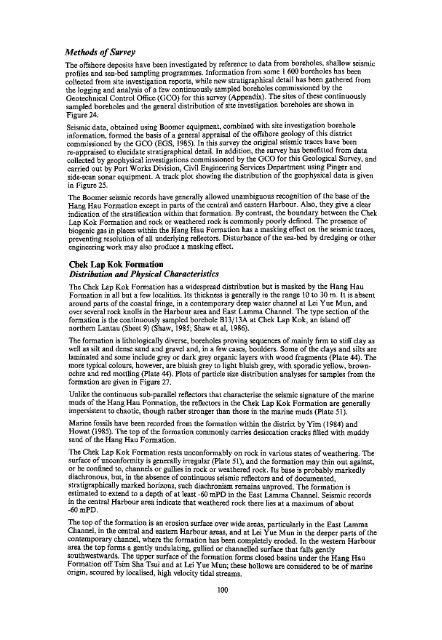Superficial Geology
Superficial Geology
Superficial Geology
You also want an ePaper? Increase the reach of your titles
YUMPU automatically turns print PDFs into web optimized ePapers that Google loves.
Methods of Survey<br />
The offshore deposits have been investigated by reference to data from boreholes, shallow seismic<br />
profiles and sea-bed sampling programmes. Information from some 1 600 boreholes has been<br />
collected from site investigation reports, while new stratigraphical detail has been gathered from<br />
the logging and analysis of a few continuously sampled boreholes commissioned by the<br />
Geotechnical Control Office (GCO) for this survey (Appendix). The sites of these continuously<br />
sampled boreholes and the general distribution of site investigation boreholes are shown in<br />
Figure 24.<br />
Seismic data, obtained using Boomer equipment, combined with site investigation borehole<br />
information, formed the basis of a general appraisal of the offshore geology of this district<br />
commissioned by the GCO (EGS, 1985). In this survey the original seismic traces have been<br />
re-appraised to elucidate stratigraphical detail. In addition, the survey has benefitted from data<br />
collected by geophysical investigations commissioned by the GCO for this Geological Survey, and<br />
carried out by Port Works Division, Civil Engineering Services Department using Finger and<br />
side-scan sonar equipment. A track plot showing the distribution of the geophysical data is given<br />
in Figure 25.<br />
The Boomer seismic records have generally allowed unambiguous recognition of the base of the<br />
Hang Hau Formation except in parts of the central and eastern Harbour. Also, they give a clear<br />
indication of the stratification within that formation. By contrast, the boundary between the Chek<br />
Lap Kok Formation and rock or weathered rock is commonly poorly defined. The presence of<br />
biogenic gas in places within the Hang Hau Formation has a masking effect on the seismic traces,<br />
preventing resolution of all underlying reflectors. Disturbance of the sea-bed by dredging or other<br />
engineering work may also produce a masking effect.<br />
Chek Lap Kok Formation<br />
Distribution and Physical Characteristics<br />
The Chek Lap Kok Formation has a widespread distribution but is masked by the Hang Hau<br />
Formation in all but a few localities. Its thickness is generally in the range 10 to 30 m. It is absent<br />
around parts of the coastal fringe, in a contemporary deep water channel at Lei Yue Mun, and<br />
over several rock knolls in the Harbour area and East Lamma Channel. The type section of the<br />
formation is the continuously sampled borehole B13/13A at Chek Lap Kok, an island off<br />
northern Lantau (Sheet 9) (Shaw, 1985; Shaw et al, 1986).<br />
The formation is lithologically diverse, boreholes proving sequences of mainly firm to stiff clay as<br />
well as silt and dense sand and gravel and, in a few cases, boulders. Some of the clays and silts are<br />
laminated and some include grey or dark grey organic layers with wood fragments (Plate 44). The<br />
more typical colours, however, are bluish grey to light bluish grey, with sporadic yellow, brownochre<br />
and red mottling (Plate 44). Plots of particle size distribution analyses for samples from the<br />
formation are given in Figure 27.<br />
Unlike the continuous sub-parallel reflectors that characterise the seismic signature of the marine<br />
muds of the Hang Hau Formation, the reflectors in the Chek Lap Kok Formation are generally<br />
impersistent to chaotic, though rather stronger than those in the marine muds (Plate 51).<br />
Marine fossils have been recorded from the formation within the district by Yim (1984) and<br />
Howat (1985). The top of the formation commonly carries desiccation cracks filled with muddy<br />
sand of the Hang Hau Formation.<br />
The Chek Lap Kok Formation rests unconformably on rock in various states of weathering. The<br />
surface of unconformity is generally irregular (Plate 51), and the formation may thin out against,<br />
or be confined to, channels or gullies in rock or weathered rock. Its base is probably markedly<br />
diachronous, but, in the absence of continuous seismic reflectors and of documented,<br />
stratigraphically marked horizons, such diachronism remains unproved. The formation is<br />
estimated to extend to a depth of at least -60 mPD in the East Lamma Channel. Seismic records<br />
in the central Harbour area indicate that weathered rock there lies at a maximum of about<br />
-60 mPD.<br />
The top of the formation is an erosion surface over wide areas, particularly in the East Lamma<br />
Channel, in the central and eastern Harbour areas, and at Lei Yue Mun in the deeper parts of the<br />
contemporary channel, where the formation has been completely eroded. In the western Harbour<br />
area the top forms a gently undulating, gullied or channelled surface that falls gently<br />
southwestwards. The upper surface of the formation forms closed basins under the Hang Hau<br />
Formation off Tsim Sha Tsui and at Lei Yue Mun; these hollows are considered to be of marine<br />
origin, scoured by localised, high velocity tidal streams.<br />
100

















